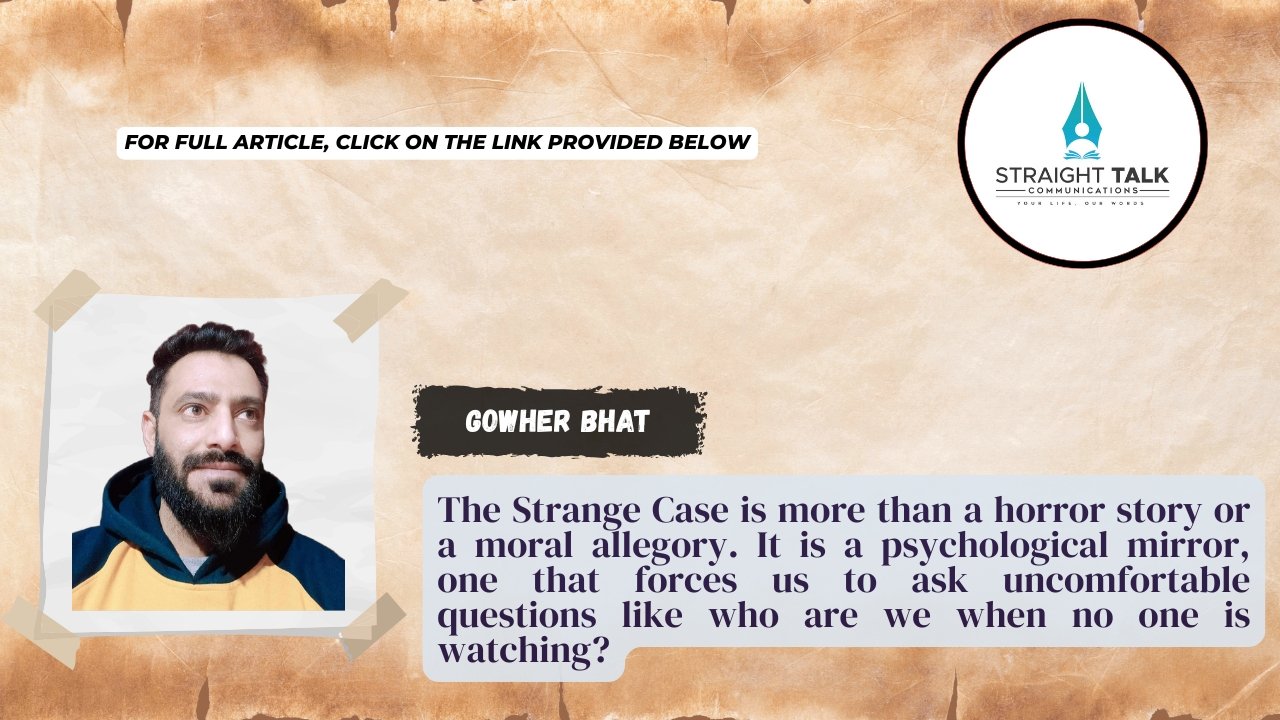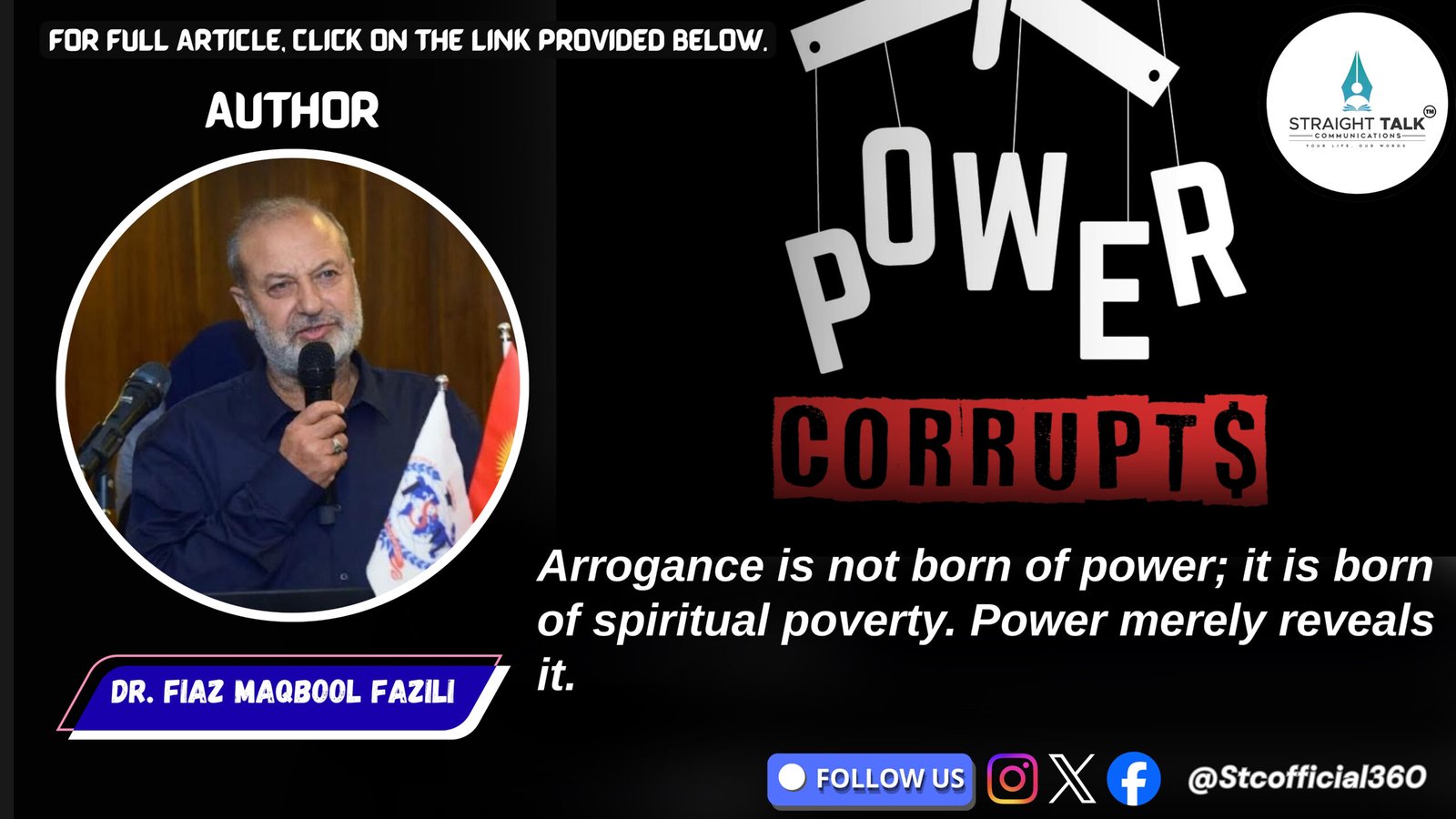The Timeless Tale of Duality: Unmasking the Psyche through Dr. Jekyll and Mr. Hyde

The Strange Case is more than a horror story or a moral allegory. It is a psychological mirror, one that forces us to ask uncomfortable questions like who are we when no one is watching?
Gowher Bhat
Robert Louis Stevenson’s The Strange Case of Dr. Jekyll and Mr. Hyde, first published in 1886, remains a hauntingly relevant exploration of the human psyche. Its enduring power lies in its examination of moral conflict, the duality of human nature, and the thin line separating civilization from chaos. A recent psychiatric lens applied to this classic—featured in the Indian Journal of Psychiatry—has shed fresh light on the novel’s psychological and philosophical depth, offering contemporary readers a richer understanding of this Victorian tale.
At its narrative core, the novel tells the story of Dr. Henry Jekyll, a well-respected London physician who harbors dark, unexpressed desires. In his pursuit to separate the noble from the nefarious within him, Jekyll concocts a potion that transforms him into Edward Hyde—a sinister figure free from the restraints of conscience. What begins as an experiment in liberation soon becomes a harrowing tale of surrender, as Hyde grows stronger and more destructive, ultimately leading to Jekyll’s downfall.
The Age-old Philosophy of Dualism
Stevenson’s narrative draws heavily from the concept of dualism—the philosophical belief that two fundamental forces, such as good and evil, soul and body, or light and darkness, exist in tension within every individual. This idea finds expression in various religious traditions. Zoroastrianism describes the struggle between Ahura Mazda (truth) and Ahra Mainyu (falsehood). In Christianity, dualism is echoed in the perpetual conflict between virtue and sin, the flesh and the spirit.
However, Stevenson takes this idea a step further. He portrays good and evil as not only coexisting but as entirely distinct and separate selves. “Man is not truly one, but truly two,” Jekyll admits in his confession. This powerful declaration moves beyond metaphor. It presents evil not as a moral failing, but as an autonomous force within the self. Hyde is not just Jekyll’s dark side—he is an entirely different being who emerges when societal restraints are removed.
This notion resonates with both religious teachings and modern psychology, suggesting that every human being contains elements of both angel and beast, and that denying one may empower the other.
Victorian Morality and the Hidden Self
Set against the backdrop of Victorian London—a time obsessed with decorum, restraint, and moral uprightness—the novel exposes a society deeply divided between public virtue and private vice. Dr. Jekyll embodies the archetype of the respectable gentleman, a physician known for his generosity and intellect. Yet beneath this facade lurks a man capable of unleashing unspeakable horrors through Mr. Hyde.
The metaphor of the back door through which Hyde comes and goes is no accident. It symbolizes how evil, rather than being eradicated, is often hidden behind closed doors and polished reputations. Stevenson’s depiction of London mirrors this duplicity: grand townhouses by day, shadowy alleys by night.
In many ways, the novel serves as a critique of the era’s moral rigidity, which encouraged suppression rather than integration of one’s darker impulses. Suppression, as the story shows, is dangerous. Denied expression in conscious life, these urges erupt in distorted, often violent forms.
Fast forward to our digital age, and Stevenson’s insights feel uncannily relevant. In an era where curated online personas are the norm, many live double lives—our real selves often hidden behind filters, usernames, and virtual facades. Like Jekyll, we are torn between the desire to conform and the longing to be free.
A Foretelling of Freudian Theory
What makes Stevenson’s tale particularly prophetic is its striking alignment with modern psychoanalytic theory—especially the work of Sigmund Freud. Though written before Freud formalized his structural model of the psyche, Dr. Jekyll and Mr. Hyde foreshadows his division of the mind into the id, ego, and superego.
Edward Hyde is the embodiment of the id: impulsive, instinctual, and concerned solely with gratification. He is devoid of empathy, guilt, or remorse. Dr. Jekyll, in contrast, is the ego—a rational figure navigating the demands of society and morality. The superego is represented by Jekyll’s conscience and by the judgment of society, which eventually drives him to despair.
As Hyde’s power grows, Jekyll’s ego weakens, unable to maintain the balance. The result is catastrophic—a chilling metaphor for the danger of repressing the darker aspects of the self rather than acknowledging and integrating them. Freud would later argue that unresolved inner conflicts often manifest in neurosis or self-destructive behavior. Stevenson’s story presents a fictional but remarkably accurate case study.
Moreover, Hyde’s appearance—“something troglodytic”—adds an evolutionary dimension. He represents not just moral regression, but biological atavism. In Victorian England, still grappling with Darwin’s theory of evolution, the fear of devolving into a primitive past was palpable. Stevenson taps into that fear with chilling precision.
Addiction, Escapism, and the Loss of Control
Modern psychiatry also views Dr. Jekyll’s potion as symbolic of substance abuse. His elixir is a tool of escape—a means to shed inhibition and explore forbidden desires. At first, the potion empowers him. But soon, like an addict, he loses control. Hyde begins to emerge without the aid of the drug. The experiment spirals into addiction, dependence, and ultimately, destruction.
This reading offers a powerful lens for understanding addiction today. Many turn to substances or risky behaviors as a way to escape inner conflict or external expectations. Yet such paths often lead to fragmentation rather than healing. Jekyll’s tragic fate stands as a cautionary tale: the pursuit of liberation through suppression and escapism can instead become a trap.
A Tale that Speaks to Kashmir and Beyond
Why does this 19th-century novel continue to grip readers today? Because it addresses a timeless truth—the human condition is not a unified, harmonious state, but a battleground of conflicting impulses.
In places like Kashmir, where tradition and modernity often coexist in tension, and where public image is deeply tied to family honor and societal expectations, the novel takes on special significance. The mask of respectability, when forced, can suffocate. Authentic living requires acknowledging—not erasing—one’s shadows.
We are all, in some form, Dr. Jekylls—striving to do good, to please society, to live upright lives. And yet, within us all, there is also a Hyde—a voice that resents constraints, seeks freedom, and flirts with danger. The key, Stevenson suggests, is not to eliminate Hyde, but to understand him. To confront the darker parts of ourselves, rather than repress them.
The Moral of the Monster
As the novel closes, Jekyll’s confession reads like a final plea: “I bring the life of that unhappy Henry Jekyll to an end.” It is not Hyde who dies—it is Jekyll, the man who tried to divide the indivisible. The message is sobering. The human soul is complex. When we seek to surgically separate its light and dark halves, we risk losing ourselves entirely.
In the end, The Strange Case of Dr. Jekyll and Mr. Hyde is more than a horror story or a moral allegory. It is a psychological mirror, one that forces us to ask uncomfortable questions: Who are we when no one is watching? What masks do we wear to survive? And what might happen if, one day, the mask refuses to come off?
For readers, the story is far from over. Its pages continue to whisper an enduring truth: only by facing the full spectrum of our nature—good and bad, noble and base—can we hope to live in harmony with ourselves.
(Gowher Bhat is a published author, freelance journalist, and English instructor based in Kashmir.)







